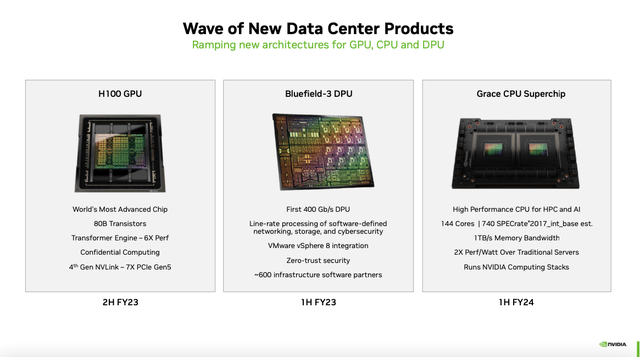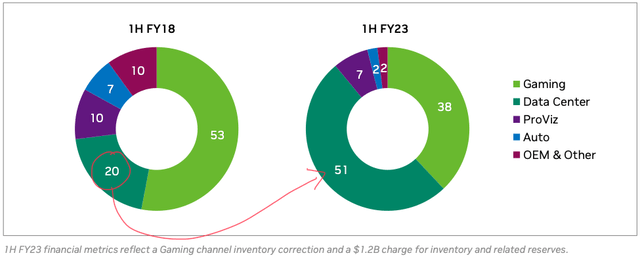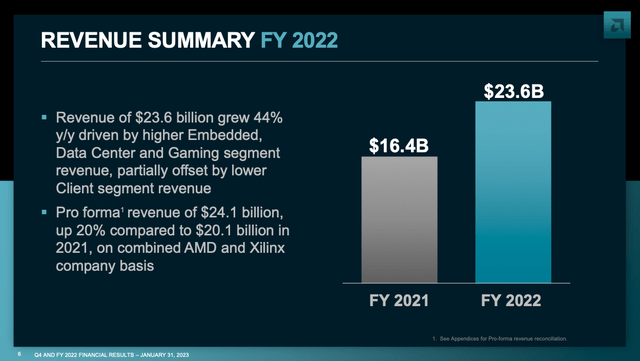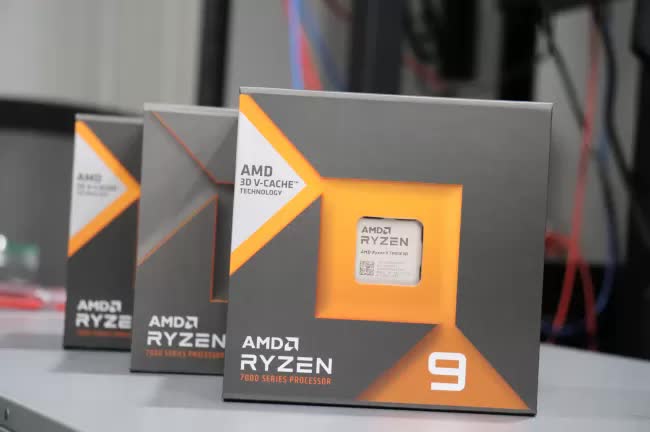Summary:
- The AI Wars should significantly boost and support the growth outlook for Advanced Micro Devices, Inc., and even more heavily NVIDIA Corporation, for the foreseeable future.
- Both stocks have partly recovered from the recent plunge in 2022, with Nvidia having an impressive recovery of around 65% YTD.
- The market is undervaluing AMD’s bright prospects in the data center, and the stock price remains below my short-term target price of $100.
- The AI hype has aided in closing NVDA’s undervaluation gap, offering limited upside potential from current levels.
mesh cube
Market Outlook & Investment Thesis
In October 2022, the Biden administration introduced export sanctions on specific technologies, including integrated circuits and wafer fabrication equipment for semiconductor chips. The new regulations were introduced in response to concerns about national security and intellectual property theft, particularly by Chinese companies.
The impact of these export sanctions was significant in the integrated circuits and wafer fabrication equipment industries. NVIDIA Corporation (NASDAQ:NVDA) estimated that its quarterly revenue could dip by $400 million if Chinese buyers were excluded, which caused its stock price to plummet. The new regulations will be phased in before full implementation in September 2023, so Nvidia will have time to adjust to the new regulatory environment.
Shortly before the announcement in October, all semiconductor stocks were declining, but NVDA has suffered the most with around a 40% plunge. On the contrary, Advanced Micro Devices, Inc. (NASDAQ:AMD) stock was more resilient to these forces, but the overall negative sentiment on the sector has suppressed AMD’s valuations to lower levels, creating a very attractive entry point.
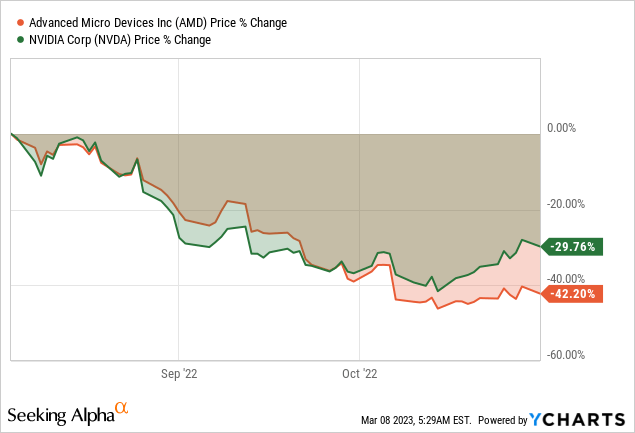
Two months later, the market has already rewarded Nvidia for its exposure to the AI hype supported by the OpenAI (i.e., ChatGPT). Despite the strong pullback, NVDA had a strong bull run YTD with a staggering 65% return. However, both stocks remain below their all-time high levels, but AMD offers a more attractive risk/reward profile for the moment, earning the buy rating, while NVDA is a hold since most of the improving outlook has already been priced in the stock.
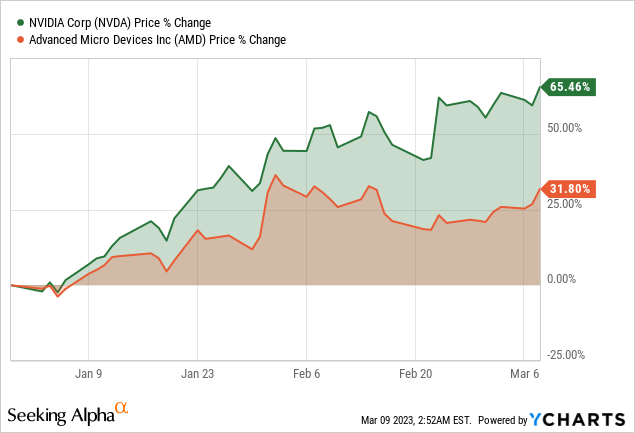
AI Growth Supports Nvidia’s Potential
Nvidia is anticipating continued challenges in the coming quarter due to its ongoing efforts to fix some of its activities. However, the management expects a recovery later in the year. Despite a sharp decline in the gaming unit caused by a drop in PC sales and excess inventory, the demand for new graphics cards is expected to remain strong, which should help the unit to regain its growth.
Additionally, the company is confident that its data center products will experience accelerating sales growth, supported by strong interest among cloud providers, internet firms, and enterprises to invest in Artificial Intelligence (AI). The popularity of generative AI tools has increased the adoption of AI and is seen as a turning point in this regard. The company plans to capture even more potential growth in AI through a new cloud service for enterprise customers. Nvidia’s GPUs, advanced networking products, and software functionality are expected to remain in high demand due to their ability to provide computing power for complex AI models.
The company’s latest flagship product, Hopper (H100) GPU, offers significant acceleration in computing power, which is essential when demand for such technology is increasing, mainly due to the popularity of generative AI tools like OpenAI’s ChatGPT. More specifically, the H100 is up to 30 times faster at AI inferencing for transformer-based large language models like Open AI’s ChatGPT than its predecessor. As a result, the AI Wars and intense competition between Microsoft Corporation (MSFT) and Alphabet Inc. (GOOGL) should support Nvidia’s growth for the foreseeable future.
Despite some hyper-scale cloud providers’ austerity measures, Nvidia is expected to thrive due to the massive investments from Meta Platforms, Inc. (META) and Microsoft in AI and machine learning workloads. As a result, the market for AI networking is expected to grow to over $8 billion in 2027, with a CAGR of approximately 40%, with Nvidia being a key beneficiary of it.
Nvidia is confident in the growth potential of its data center unit, its fastest-growing segment with a 5-year CAGR of 66%, surpassing the gaming segment’s growth and accounting for 40% of revenue in 2022. The company expects the data center segment to reach 51% of revenues in the first half of 2023, as significant spending from large cloud and internet companies, start-ups, and enterprises keen to invest in AI.
In response to this growing interest, Nvidia has introduced a new AI Cloud Service called Nvidia DGX Cloud. The service will be hosted by major cloud providers such as Microsoft, Oracle, and Google and will offer access to the Nvidia AI Enterprise software suite to train large language models on Nvidia’s DGX systems. The service targets companies looking to create AI models and services by combining public and private infrastructure.
The gaming activities are expected to resume growth this year as large excess inventories have mostly been cleared. The recent collapse in card demand results from severe PC weakness, excess inventories, and renewed crypto-related disruption. However, there is evidence of high interest in Nvidia’s latest graphics cards for PC gaming. The firm’s products remain very competitive, and the management is also putting the firm in a strong position to benefit from emerging trends, such as allowing gamers to stream games from the cloud and play these on any device. The approach can extend the firm’s gamer reach and fuel demand for Nvidia’s data center products.
Nvidia’s partnership with Foxconn to build automated EVs could aid its automotive segment, which has about $11 billion in design wins. Though the unit’s sales growth was muted last year compared with rival Qualcomm, I consider Nvidia’s full suite of software and graphic chip capabilities may drive faster revenue gains from the legalization of driverless vehicles.
AMD Enjoys An Increasing Data-center Share But Weakening PC Market Demand
Inventory correction and weak demand in PCs will likely persist through 1H as AMD continues to under-ship to clear the channel before recovery resumes in 2H23 in its Client and Gaming segments. However, share gains in its Data Center segment and ramp-ups from next-generation product launches with higher ASPs (EPYC and Genoa) could spur year-over-year (YoY) growth. Although weak demand for client PCs and Gaming may continue to pressure 1H, growth could resume in 2H after inventory normalizes.
AMD is improving its competitiveness across CPU and GPU products with Ryzen, EPYC, and Radeon Vega platforms and is on track to improve its market share and drive meaningful revenue growth in the near term. However, long-term share gains are less certain, and AMD must invest heavily in R&D to keep pace with the market leaders.
AMD’s December quarter results were strong due to improved revenues from Data-center and Embedded segments, which offset the continued weak demand in PC/Gaming and inventory work downs across the PC supply chain. The company expects the PC/Gaming demand weakness to continue into the March quarter, along with a 1H data-center customer inventory digestion. As a result, the management has provided conservative guidance for the March quarter and has refrained from providing full-year 2023 guidance like its peer companies. However, the management is more optimistic about the potential YoY revenue growth in 2023 driven by growth in its Data-center and Embedded businesses, combined with continued market share gains.
Given the strategic importance of AMD’s high-performance CPUs to support its customers’ AI/analytics initiatives, the team has strong visibility into its cloud customer roadmap, where spending remains resilient. Additionally, given the lower mix of Data-center sales and PC pricing headwinds, the management expects the margin to trend in the 50% range through the 1H of the year before expanding in the 2H of the year as demand recovers.
Overall, while the PC client business is undergoing substantial declines to burn off excess inventory, the team is exiting this downturn with a much more diversified business model, which is in part a reflection of the team’s strategic initiatives. To put it into perspective, the PC client business for AMD is 15-17% of sales, whereas Intel Corporation’s (INTC) is 43-45% of sales.
Though weakness in its Client and Gaming segment was no surprise, given prevailing inventory digestion and weak demand in PCs, AMD’s share gain in Data centers and relative strength in its semi-custom business could help it outperform rivals despite a challenging economic backdrop. Despite softness in the data-center market and elevated inventory at some cloud customers, AMD is confident it can leverage recent share gains and drive YoY growth in its Data Center segment, fueled by new product ramp-ups and higher average selling prices.
However, with the outgoing Chief Financial Officer Devinder Kumar, appointing a new CFO could create some execution risk. In addition, top-line growth is likely to decelerate amid a down cycle in semiconductors. Lastly, supply-chain diversification will be a key challenge for new CFO Jean Hu amid U.S.-China tensions.
AMD’s 3D V-Cache Packaging Technology Could Unseat Intel
AMD could retake the lead in gaming CPUs with its new Ryzen 7000 series chips with 3D V-Cache memory technology. The company’s Ryzen 5800 3D V-Cache memory struggled with compute performance, especially for non-gaming workloads, and was quickly overtaken by Intel’s 13th-generation Raptor Lake processors.
The new Ryzen 9 7900X3D series, unveiled at CES 2023, has overcome those issues and may become the preferred CPU for gamers. In addition, the new chips put memory even closer to the processor for faster speeds. On the other side, Intel is reportedly close to launching a new version of Raptor Lakes that will challenge AMD. However, as packaging advances, next-generation DDR5 adoption will rise, driving revenue and margin growth for memory suppliers.
Ryzen 9 7900X3D (www.phoronix.com)
Conclusion
Due to macroeconomic uncertainty, Advanced Micro Devices, Inc. did not issue a full-year forecast. Still, it is reasonable to expect that AMD will resume double-digit sales growth in the second half of 2023. As long as the market remains concerned with AMD’s declining PC and gaming revenues while undervaluing AMD’s bright prospects in the data center, the AMD stock price remains below my short-term target price of $100.
On the contrary, despite the optimism in the market and the improved outlook, Nvidia stock trades around its fair value. Therefore, the recent AI hype has aided in closing Nvidia Corporation’s undervaluation gap, with shares offering limited upside potential from current levels and an unfavorable risk/reward profile.
Disclosure: I/we have a beneficial long position in the shares of AMD, INTC, TSM either through stock ownership, options, or other derivatives. I wrote this article myself, and it expresses my own opinions. I am not receiving compensation for it (other than from Seeking Alpha). I have no business relationship with any company whose stock is mentioned in this article.

